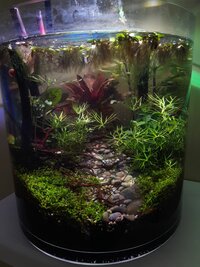I have a Fluval spec sitting in the garage and plan to have a play with a dirted tank once the kitchen decorating in finished. I’m just going to use what I have lying around already - some potting soil and sand to cap, some previously used hardscape and whatever trimmings or plants I have spare from my main tank. I also have spare filter media in this tank I plan to move over
I am expecting the soil will leach a lot of ammonia - should I buy a test kit to monitor the levels? Don’t normally use test kits, but I’m a bit worried the ammonia leach will get high enough to kill off the bacteria in the media and possibly the plants.
If it works well, I will keep it running and get a betta for it 😊
I am expecting the soil will leach a lot of ammonia - should I buy a test kit to monitor the levels? Don’t normally use test kits, but I’m a bit worried the ammonia leach will get high enough to kill off the bacteria in the media and possibly the plants.
If it works well, I will keep it running and get a betta for it 😊



